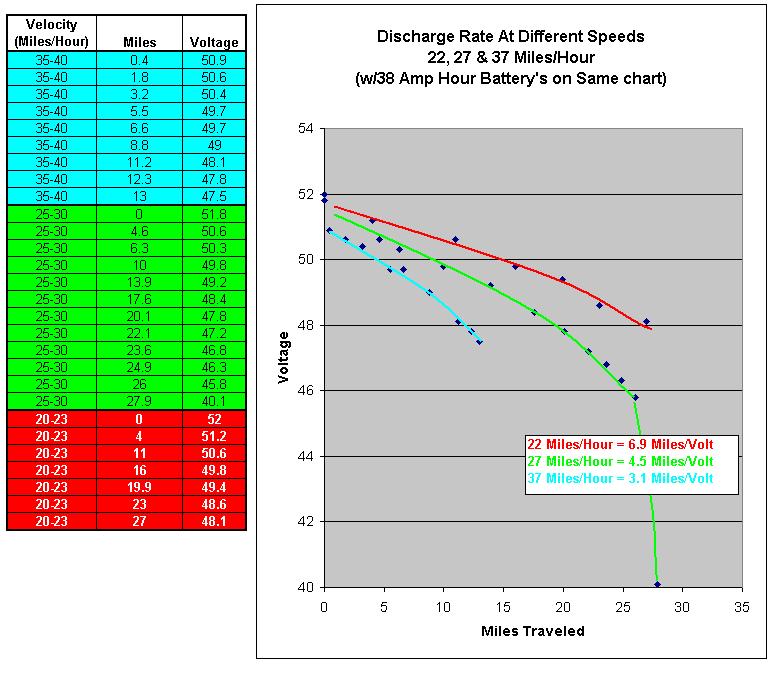Benchmarking Performance of Un-faired Motorcycle
(Back to Home)

The following data was collected using the following equipment: SMALL BATTERY PACK: Four (4) BB Battery Model EB-20-12 Sealed Lead Acid Batteries (SLA) wired in series to form a “48Volt” battery system. Published 30Min. Discharge Capacity is approximately 12 amp-hours. Total system is therefore good for about 576 watts during a 30 minute ride (48v x 12 amps). LARGE BATTERY PACK: Four (4) Full River Model HGL-38-12 Sealed Lead Acid Batteries wired in series to form a 48Volt battery system. A Perm-132 Motor with Altrax 4834 Controller was used with a 0-5K Magnura Twist throttle wired in parallel with a 0-10K potentiometer to help dial in a precise 25 mph velocity (by setting the 0-10K potentiometer at a certain setting, I can twist the Magnura twist grip to full throttle). The 10k potentiometer also makes the bike easier to load into my van (with ramps) and makes it safer to creep around in tight spaces and it provides good control over my hot rodding. Variable A Volt-Ohm meter is mounted just in front of the seat. I recorded the voltage every few miles by coming to a complete stop, (turning off all sources of battery drain) and letting batteries rest for 15-30 seconds before recording voltage. |
20 Amp-Hour Batteries: Range at 25mph = 13 miles. See chart below:
|
20 Amp-Hour Batteries: Range at 20mph = 18 miles. See chart below:
|
|
July 23, 2007. Range increased to 28 miles at 25-28 mph with 38 amp-hour batteries installed (Full River HGL38-12). The larger batteries added about 60 pounds to the total vehicle weight. Chart below shows performance difference between 20 and 38 amp-hour batteries: 
|
|
May 13, 2008. Chart below shows Impact of Velocity on Range (with 38 amp-hour batteries installed). Range at 22 mph = 35 miles Range at 27mph = 28 miles Range at 37mph = 15 miles 
|
|
The following quote is from http://www.electricmotorbike.org/index.php?page=lectra Note: The Lectra motorcycle had a 24 volt system. “The amount of energy remaining in a battery can be correlated to "open-circuit" battery voltage. This is the voltage the battery has when there in no load on the battery (i.e. it is no being used). As long as the battery is in an open circuit state, the voltage is an accurate measurement of the energy remaining. However, as soon as power is pulled from the battery (i.e. a loaded, or "closed" state), then voltage drops in proportion to the amount of current being drawn from the battery. In this way, a volt meter can also tell an experienced person how much current is being drawn, by watching the amount of voltage swing -- from "open circuit" to a loaded condition on the battery. Usually, an electric vehicle is having current drawn from the battery. Therefore, using a volt meter requires that the driver shut the throttle off, let the battery voltage "rest", then see how much energy remains. A full battery pack on the Lectra will exhibit about 26.5 volts. An empty battery pack exhibits about 20.5 volts. Therefore, if you have 23.5 volts remaining, the battery pack is about half full. Digital control algorithms can be used to compensate for fluctuating voltage -- voltage fluctuates whenever a load is placed on the batteries.” |
| August 2, 2008: I have ridden the motorcycle over 1,300 miles and at rest voltage has been an excellent indicator of battery status. I go on 20 mile rides (at 28mph) with confidence that I will have spare energy when I get home. My favorite rides are to Lake Michigan (a 20 mile round trip) and down to a park on the Grand River (a 15 mile round trip). I often will take along one of my sons or my wife. It is a nice ride in that we are going slow enough to carry on conversation without wind noise being a problem. |
|
August 2, 2008: I purchased a Kill-A-WATT P3 energy meter from Amazon.com to measure my energy usage during charging with my Nivan Charger. After a 29 mile ride discharged to 46 volts on my 38Amp-Hour 48 Volt battery pack, these are the summary results: Kilo-Watt Hours to recharge = 1.81 Cost at $.10/kWh = $.18  Detailed charging data:    |
June 2009: The following graph shows actual power used to attain various velocities (test conditions = on flat ground, no wind, speed steady, rider fully tucked positions with dustbin fairing plus red windshield on the bike): |